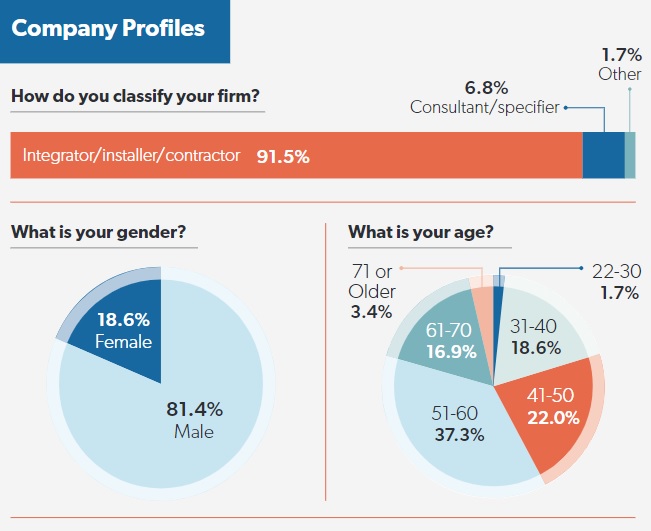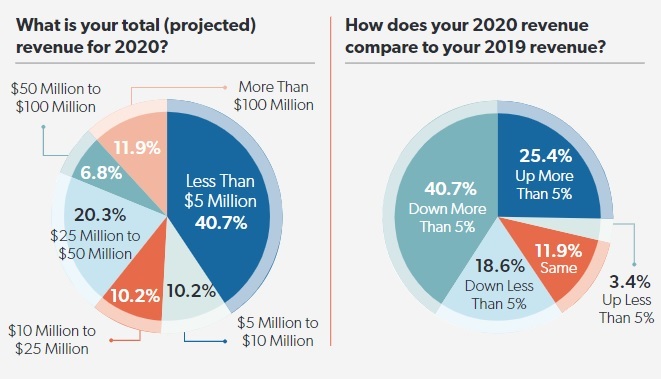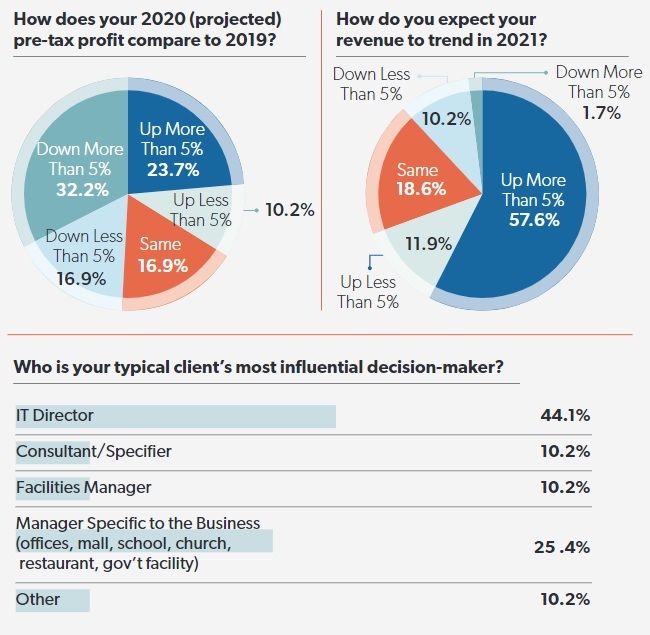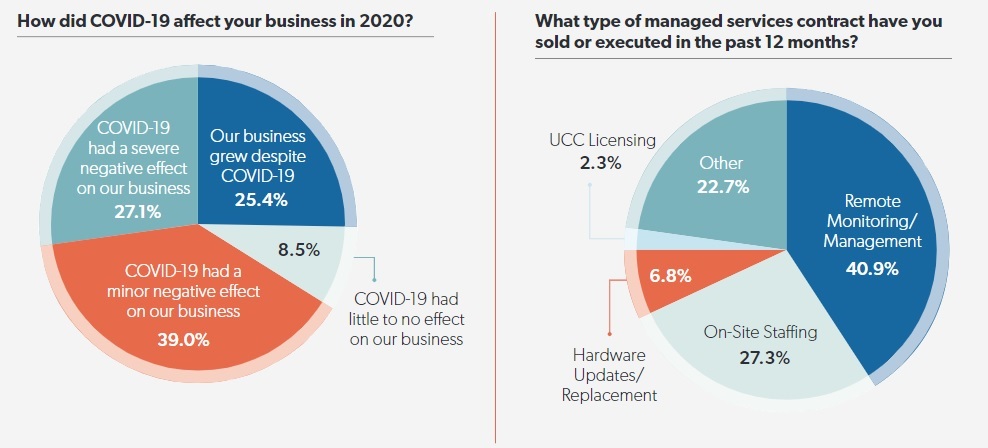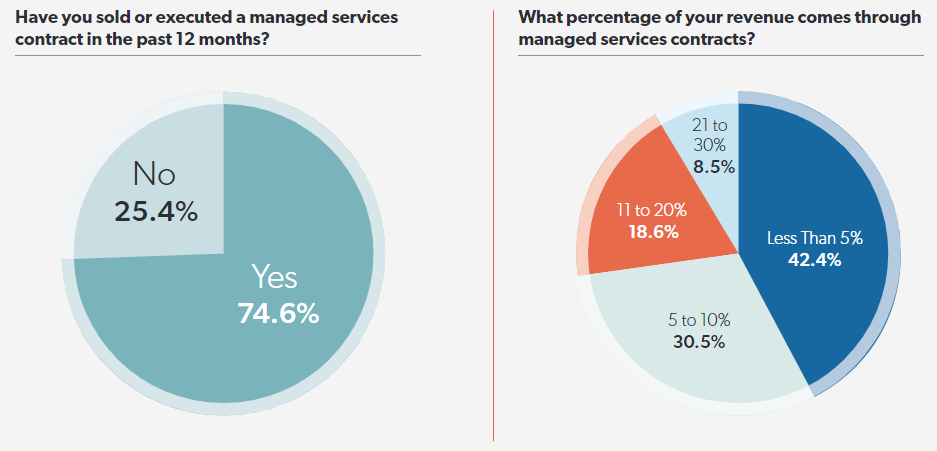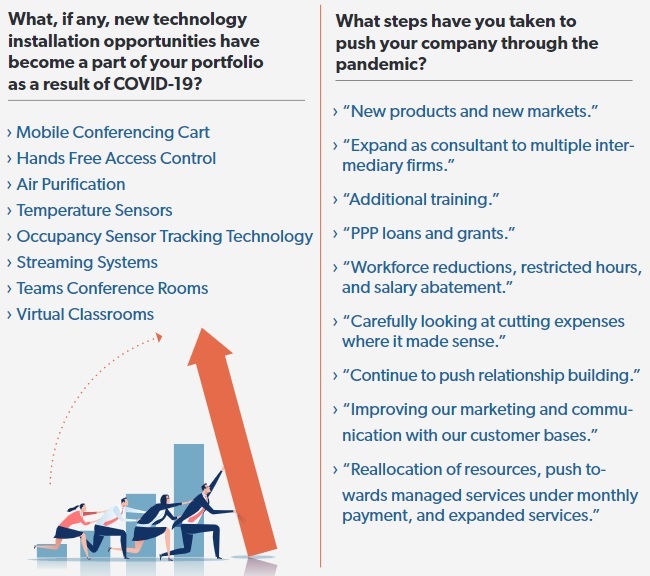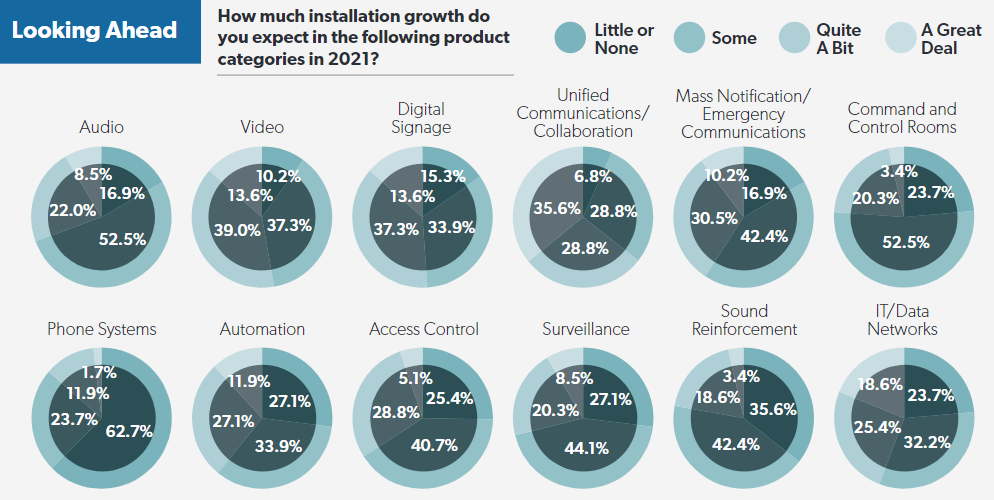Last year at this time, the people we interviewed for the purposes of helping us look ahead to 2020 and what was likely to happen across the AV landscape almost universally saw it as another year of growth for many in the space, without a hint of recession or trouble ahead.
So you might want to grab a grain of salt before you dive too far into this year’s look ahead to 2021, but we’re hoping that there won’t be a surprise that’s as jarring and all-encompassing as the coronavirus pandemic within the next 12 months.
What does look like it’s on the horizon is a continuation of the phenomenon that packed five years of tech innovation into the final nine months of the year.
Things will look a lot different than they did two years ago, but AV is uniquely poised to answer the call in many of the transitions that lay ahead.
“Every call last year was talking about growth, record backlog and how they couldn’t keep up with the demand,” says NSCA executive director Chuck Wilson.
“Now we’re thinking first and foremost about the survival of each and every one of our member companies.”
NSCA has been helping members with financial health checks and making sure employment levels match demand, he says.
The average company expects a 20 percent drop in revenue and about the same reduction in efficiency, says Wilson.
After predictions of another robust year ahead in 2020, AVIXA CEO David Labuskes “certainly received a lesson this year that there are no certainties,” he says with a smile. For 2021, he expects people to be “back out in the world by the middle of 2021.
“This is like the end of Season 1 of some new blockbuster series and we’ve got a number of different plot points that are going to resolve when 2021 hits,” says Labuskes. Those “unresolved plot points” include the economy, presidential election, possible stimulus package and coronavirus vaccine.
“From a technological perspective, I think we’re going to enter a time frame of unprecedented growth and innovation,” he says.
“We will bring lessons from this time frame forward with us and have different behavior. It’s going to be an extraordinarily exciting and rich time frame for people in the AV industry.
“The experience will be so much more richly valued at the next concert you can attend or the next sports contest you can be part of than any experience you’ve had before. That will underscore what we do as an industry,” says Labuskes.
That doesn’t mean it will be easy to get there, but AV can help to bridge the gap for a lot of the problems we’ve run into in terms of communication and staying connected.
“All of us are going to be transacting business in a face-to-face environment but that environment will be extended to those who aren’t physically present,” says Labuskes.
“That means complete reconfiguration of many different building spaces and that means work for the AV industry.”
AVIXA market intelligence predicts slow growth in 2021 and return to higher numbers than 2019 by 2022.
“In that environment, we’re going to see incoming capital that will drive innovation,” says Labuskes. Enterprises will double down on creating attractive places to work that encourage people to come to the office because of access to technology and colleagues that employees can’t get from home.
“The next iteration of the workplace is about having seamless interactions that are impossible to have with one person sitting at home,” he says.
Related: Different Managed Services Models: Does One Size Fit All?
In addition to the COVID-19 outbreak, election results from November and continued social upheaval will play roles into what 2021 brings for AV integrators, says Wilson.
“Those are all factors that tie into business to get it back to whatever normal is going to look like,” he says. “What’s it going to take to have businesses go from cash preservation mode to putting money out there to spend on an operating expense or any kind of capital improvement?
“Thankfully our members sell a lot of the technologies that are most in-demand,” says Wilson, noting the money being put into digital experiences exceeds physical upgrades for the first time.
“We’ve gotten a lot of good news,” says Wilson.
“The question is when it will happen. It all seems to tie into the wide distribution of the vaccine.” NSCA is advising members to extend the revenue models they used for the second half of 2020 into the first half of 2021.
“We’re trying to get people to not be overly excited about when this thing is going to rebuild,” says Wilson.
Bill Warnick, CEO of 2019 CI Integrator of the Year Solutionz, Inc., says 2020 was “a challenging year,” but his company’s ability to go in new directions as needed helped them navigate the market well.
“Having backlog was crucial to us, but so was being nimble in the way we managed our business,” he says.
“It’s a little like the stages of grief with our customers. There’s a big difference between trying to book projects and trying to recognize revenue. You have to finish projects to recognize the revenue.
“Large-scale integration is still the lifeblood of what we do,” says Warnick, but Solutionz also added a cybersecurity offering and increased its managed services capabilities in 2020.
“Being able to do things as a service is important, so is being able to do a subscription-based coverage of someone’s AV network,” he says. “That’s going to be a growing concern for our customers so it needs to be of utmost concern for us.
“Any integrator will tell you they make way more selling their own services than they do selling boxes,” says Warnick.
Pivot, Pivot, Pivot
We highlighted the word “transition” as the state of the AV industry for 2021 and Wilson says that’s a word AV integrators can embrace.
“Technology is enabling a lot of this stuff to happen,” he says.
“Many of our members have used this as an opportunity to build foundational strength. They’re taking a step back and asking what the workforce of the future looks like, what do we have today and what do we need to train them on to get them ready for the pent-up demand that’s ready to happen?
“As we look at all of the data coming in, it points to connectivity being mission-critical,” says Wilson. That includes social distancing protocols with spacing, hygiene, detection, sensors, surveillance and safety, among others, he says.
“We can use this time frame to look at what our company is going to be positioned like to take advantage of what’s coming in the future,” says Wilson. “What we do is going to more crucial than it’s ever been. We have an opportunity here.
“The video, the audio, everything we do is going to be what people need,” he says.
NSCA members have been hearing the word “pivot” for a few years now related to the shift to more of a managed services-based, recurring revenue model.
They’ve also started to become more IT-savvy, says Wilson, meaning they could roll out thermal detection and AI equipment during the pandemic.
“They’re starting to understand we can use our equipment to monitor air quality and how many people are in a space,” says Wilson. “As technology is evolving, 5G is going to become a bigger part of what we do.”
Labuskes highlights “opportunity” as his focus for the year ahead.
“Times of transition are when companies transform,” he says. “That demands a willingness to strike out into an environment of uncertainty, to take risks and fail fast. The ability to personalize our communication experiences will be desired in a corporate entity. Those who embrace that will enjoy great success.”
People will always need information when they go to concerts, a house of worship or a sporting event, but now that information is more focused on safety, says Labuskes.
He’s looking forward to what he’s called “the better normal,” not just in 2021 but 10 years from now and beyond.
Warnick embraces and transition, saying they both are forms of change and that’s a world in which he thrives.
“If you’re in the AV industry and you’re astute enough to see it, you’re going to find opportunity,” he says. “There’s uncertainty that creates challenges but there’s also opportunity.”
Return to Live Events, M&A
NSCA recently announced that the 2021 Business & Leadership Conference will be a virtual offering in February rather than a live event as scheduled in Dallas. That decision was driven in part by the fact that about one in 10 NSCA members say they’re ready to travel early in 2021.
“I know what people want,” says Wilson. “They’d love to get back together and be face to face. It will happen but we don’t know when. It isn’t just about the vaccine or treatment is going to be available. We need some time to rebuild our company too.
“We’re getting better and better at delivering the content and trying to create the best we can where people can see each other. We’re trying to keep our community intact. These are people who became such good friends because of events like BLC,” he says.
Labuskes has seen AV take great strides in delivering virtual events in 2020 and expects that to continue.
“I don’t know that we could have gotten worse,” he says.
“You have to recognize you have a different medium. You can convert a book to a movie by having someone read the pages of the book and filming it. None of us have really done a hybrid event yet.
“There are a lot of assumptions we need to make sure we challenge when putting together hybrid events. One is that they have to be simultaneous. When you release the bounds of physical connectivity, you release the bounds of time,” says Labuskes.
“Another is the word ‘event’ needs to be re-examined,” he says. “Is it a four-hour event or a journey you take in the way you want to take it? Networking is an area for us to explore, experiment with, make mistakes and refine. It’s an area where AV as an industry is perfectly poised.
“We’ve been putting disparate components into a system to create an experience” says Labuskes. “I’m hungry to see what our industry delivers in this regard.”
InfoComm 2021 is scheduled for mid-June in Orlando, Fla., and Labuskes says that plan remains as long as AVIXA can deliver the event safely.
“Those who’ve said we’ll have virtual meetings from this point forward understand we need more than that to function as a human race, to perform as a business, to celebrate with family,” he says. “The thing about holding a show is not about us having a show, it’s that our industry is hungry for a show.
Listen: Keeping the Live Events Industry Alive This Winter: Episode 132 of AV+
“We really feel obligated to deliver the show if we can do so at all in a safe manner. The value of creating the hands-on, visceral experience of the event and reinforcement of brand level is incalculable. I am optimistic but I’m also certain the show won’t look like it did in 2019,” says Labuskes.
“I don’t think we’ll be setting attendance records, and frankly I’m not sure that would be a good idea, but I am confident we can achieve the purpose of the show,” he says. “If we are able to demonstrate that it’s safe, the human nature part is something you can conceive of.
“What we’re anticipating is more than half of what we had in the past. I would be disingenuous to suggest we’d have 45,000 people there,” says Labuskes.
Even those who own and operate convention centers believe the hybrid model will be the new standard, says Wilson.
“When things come back, they’re going to come back a little differently,” he says.
Wilson isn’t sure the transition from Donald Trump to Joe Biden as U.S. president will affect integrators in ways beyond increased taxation.
“We don’t see a heightened level of legislation that are going to be signed as executive orders on the first day (of Biden’s term),” he says.
Even so, he’s urging all NSCA members to take a “realistic and historic look at backlog and take it project by project” when creating 2021 budgets.
“I can’t stress enough the fundamentals of business rather than the hope and hype that vaccine is going to allow you to jack up your billing rate,” says Wilson. “We fell off the cliff and now we’re climbing back up. I’m wildly optimistic about the second half of 2021.”
About 30 to 40 acquisitions involving NSCA members got put on hold because of the pandemic, says Wilson. He expects the brisk pace of deals we saw from 2016 through early 2020 to pick up at some point in 2021.
“My guess is about the same time as the vaccine, the private equity firms and strategic acquisitions will move back to the front burner,” says Wilson.
Labuskes expects more deals as the business landscape gains more clarity.
“One of the things that is fundamental to business is businesses don’t like uncertainty,” he says. “If there’s certainty about growth or contraction, those are easy to manage around. As those clouds drift away and horizon becomes clearer, we’re going to see a reaffirmation of the core value of our industry.”
That value, says Labuskes, includes the experience economy, differentiation, connecting people to people, agility and mobility and notes “all of that is enabled by our technologies.
“If there’s a macroeconomic headwind on the AV industry, that also tends to drive mergers and acquisitions,” he says.
Warnick vows Solutionz will continue to be active on the M&A front after closing 2019 by acquiring Unified Technology Systems in Atlanta, one of the last major deals of the year in AV.
“We’re still in acquisition mode,” he says. “I think we’re going to see an uptick in acquisitions. In challenging times, some people are going to sink and some are going swim. We’re talking to multiple people about multiple opportunities.
“There are ebbs and flows all the way until you sign on the line. We see that regardless of the climate and regardless of what’s going on in the world,” says Warnick, noting the Unified deal took about two years to consummate in a thriving economy.
As the integration industry transitions into 2021 a bit of cautious optimism is fair to harbor, and as we move into 2022 we hope that this transition will position integrators as key partners in the planning of new building projects.


